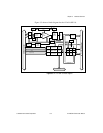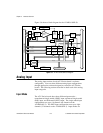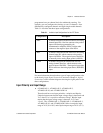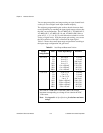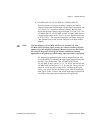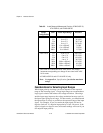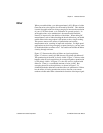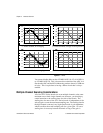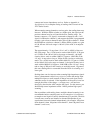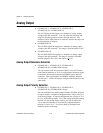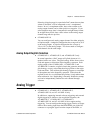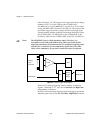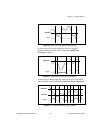
Chapter 3 Hardware Overview
National Instruments Corporation 3-13 AT-MIO/AI E Series User Manual
constant and source impedances are low. Refer to Appendix A,
Specifications, for a complete listing of settling times for each of the
AT E Series boards.
When scanning among channels at various gains, the settling times may
increase. When the PGIA switches to a higher gain, the signal on the
previous channel may be well outside the new, smaller range. For
instance, suppose a 4 V signal is connected to channel 0 and a 1 mV
signal is connected to channel 1, and suppose the PGIA is programmed
to apply a gain of one to channel 0 and a gain of 100 to channel 1. When
the multiplexer switches to channel 1 and the PGIA switches to a gain
of 100, the new full-scale range is 100 mV (if the ADC is in unipolar
mode).
The approximately 4 V step from 4 V to 1 mV is 4,000% of the new
full-scale range. For a 12-bit board to settle within 0.012% (120 ppm
or 1/2 LSB) of the 100 mV full-scale range on channel 1, the input
circuitry has to settle to within 0.0003% (3 ppm or 1/80 LSB) of the
4 V step. It may take as long as 100 µs for the circuitry to settle this
much. For a 16-bit board to settle within 0.0015% (15 ppm or 1 LSB)
of the 100 mV full-scale range on channel 1, the input circuitry has to
settle within 0.00004% (0.4 ppm or 1/400 LSB) of the 4 V step. It may
take as long as 200 µs for the circuitry to settle this much. In general,
this extra settling time is not needed when the PGIA is switching to a
lower gain.
Settling times can also increase when scanning high-impedance signals
due to a phenomenon called charge injection, where the analog input
multiplexer injects a small amount of charge into each signal source
when that source is selected. If the impedance of the source is not low
enough, the effect of the charge—a voltage error—will not have
decayed by the time the ADC samples the signal. For this reason, you
should keep source impedances under 1 kΩ to perform high-speed
scanning.
Due to problems with settling times, multiple-channel scanning is not
recommended unless sampling rates are low enough or it is necessary
to sample several signals as nearly simultaneously as possible. The data
is much more accurate and channel-to-channel independent if you
acquire data from each channel independently (for example, 100 points
from channel 0, then 100 points from channel 1, then 100 points from
channel 2, and so on).



